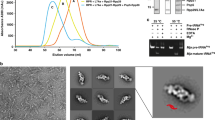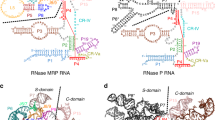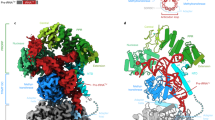Abstract
Transfer RNA (tRNA) is produced as a precursor molecule that needs to be processed at its 3′ and 5′ ends. Ribonuclease P is the sole endonuclease responsible for processing the 5′ end of tRNA by cleaving the precursor and leading to tRNA maturation. It was one of the first catalytic RNA molecules identified1 and consists of a single RNA component in all organisms and only one protein component in bacteria. It is a true multi-turnover ribozyme and one of only two ribozymes (the other being the ribosome) that are conserved in all kingdoms of life. Here we show the crystal structure at 3.85 Å resolution of the RNA component of Thermotoga maritima ribonuclease P. The entire RNA catalytic component is revealed, as well as the arrangement of the two structural domains. The structure shows the general architecture of the RNA molecule, the inter- and intra-domain interactions, the location of the universally conserved regions, the regions involved in pre-tRNA recognition and the location of the active site. A model with bound tRNA is in agreement with all existing data and suggests the general basis for RNA–RNA recognition by this ribozyme.
This is a preview of subscription content, access via your institution
Access options
Subscribe to this journal
Receive 51 print issues and online access
$199.00 per year
only $3.90 per issue
Buy this article
- Purchase on Springer Link
- Instant access to full article PDF
Prices may be subject to local taxes which are calculated during checkout



Similar content being viewed by others
References
Guerrier-Takada, C., Gardiner, K., Marsh, T., Pace, N. & Altman, S. The RNA moiety of ribonuclease P is the catalytic subunit of the enzyme. Cell 35, 849–857 (1983)
Christian, E. L., Zahler, N. H., Kaye, N. M. & Harris, M. E. Analysis of substrate recognition by the ribonucleoprotein endonuclease RNase P. Methods 28, 307–322 (2002)
McClain, W. H., Guerrier-Takada, C. & Altman, S. Model substrates for an RNA enzyme. Science 238, 527–530 (1987)
Kirsebom, L. A. & Svard, S. G. Base pairing between Escherichia coli RNase P RNA and its substrate. EMBO J. 13, 4870–4876 (1994)
Christian, E. L., Kaye, N. M. & Harris, M. E. Evidence for a polynuclear metal ion binding site in the catalytic domain of ribonuclease P RNA. EMBO J. 21, 2253–2262 (2002)
Beebe, J. A., Kurz, J. C. & Fierke, C. A. Magnesium ions are required by Bacillus subtilis ribonuclease P RNA for both binding and cleaving precursor tRNAAsp. Biochemistry 35, 10493–10505 (1996)
Perreault, J. P. & Altman, S. Pathway of activation by magnesium ions of substrates for the catalytic subunit of RNase P from Escherichia coli. J. Mol. Biol. 230, 750–756 (1993)
Smith, D. & Pace, N. R. Multiple magnesium ions in the ribonuclease P reaction mechanism. Biochemistry 32, 5273–5281 (1993)
Kurz, J. C. & Fierke, C. A. Ribonuclease P: a ribonucleoprotein enzyme. Curr. Opin. Chem. Biol. 4, 553–558 (2000)
Pannucci, J. A., Haas, E. S., Hall, T. A., Harris, J. K. & Brown, J. W. RNase P RNAs from some Archaea are catalytically active. Proc. Natl Acad. Sci. USA 96, 7803–7808 (1999)
Reich, C., Olsen, G. J., Pace, B. & Pace, N. R. Role of the protein moiety of ribonuclease P, a ribonucleoprotein enzyme. Science 239, 178–181 (1988)
Loria, A. & Pan, T. Domain structure of the ribozyme from eubacterial ribonuclease P. RNA 2, 551–563 (1996)
Krasilnikov, A. S., Yang, X., Pan, T. & Mondragón, A. Crystal structure of the specificity domain of ribonuclease P. Nature 421, 760–764 (2003)
Krasilnikov, A. S., Xiao, Y., Pan, T. & Mondragón, A. Basis for structural diversity in homologous RNAs. Science 306, 104–107 (2004)
Chen, J.-L. & Pace, N. R. Identification of the universally conserved core of ribonuclease P RNA. RNA 3, 557–560 (1997)
Massire, C., Jaeger, L. & Westhof, E. Derivation of the three-dimensional architecture of bacterial ribonuclease P RNAs from comparative sequence analysis. J. Mol. Biol. 279, 773–793 (1998)
Harris, M. E. et al. Use of photoaffinity crosslinking and molecular modeling to analyse the global architecture of ribonuclease P RNA. EMBO J. 13, 3953–3963 (1994)
Guerrier-Takada, C. & Altman, S. Reconstitution of enzymatic activity from fragments of M1 RNA. Proc. Natl Acad. Sci. USA 89, 1266–1270 (1992)
Harris, M. E., Kazantsev, A. V., Chen, J. L. & Pace, N. R. Analysis of the tertiary structure of the ribonuclease P ribozyme-substrate complex by site-specific photoaffinity crosslinking. RNA 3, 561–576 (1997)
Brown, J. W. et al. Comparative analysis of ribonuclease P RNA using gene sequences from natural microbial populations reveals tertiary structural elements. Proc. Natl Acad. Sci. USA 93, 3001–3006 (1996)
Massire, C., Jaeger, L. & Westhof, E. Phylogenetic evidence for a new tertiary interaction in bacterial RNase P RNAs. RNA 3, 553–556 (1997)
Siegel, R. W., Banta, A. B., Haas, E. S., Brown, J. W. & Pace, N. R. Mycoplasma fermentans simplifies our view of the catalytic core of ribonuclease P RNA. RNA 2, 452–462 (1996)
LaGrandeur, T. E., Huttenhofer, A., Noller, H. F. & Pace, N. R. Phylogenetic comparative chemical footprint analysis of the interaction between ribonuclease P RNA and tRNA. EMBO J. 13, 3945–3952 (1994)
Odell, L., Huang, V., Jakacka, M. & Pan, T. Interaction of structural modules in substrate binding by the ribozyme from Bacillus subtilis RNase P. Nucleic Acids Res. 26, 3717–3723 (1998)
Loria, A. & Pan, T. Recognition of the T stem-loop of a pre-tRNA substrate by the ribozyme from Bacillus subtilis ribonuclease P. Biochemistry 36, 6317–6325 (1997)
Zahler, N. H., Christian, E. L. & Harris, M. E. Recognition of the 5′ leader of pre-tRNA substrates by the active site of ribonuclease P. RNA 9, 734–745 (2003)
Tsai, H. Y., Masquida, B., Biswas, R., Westhof, E. & Gopalan, V. Molecular modeling of the three-dimensional structure of the bacterial RNase P holoenzyme. J. Mol. Biol. 325, 661–675 (2003)
delaFortelle, E. & Bricogne, G. Maximum-likelihood heavy-atom parameter refinement for multiple isomorphous replacement and multiwavelength anomalous diffraction methods. Methods Enzymol. 276, 472–494 (1997)
Murshudov, G. N., Vagin, A. A. & Dodson, E. J. Refinement of macromolecular structures by the maximum-likelihood method. Acta Crystallogr. D 53, 240–255 (1997)
Brunger, A. T. et al. Crystallography & NMR system: A new software suite for macromolecular structure determination. Acta Crystallogr. D 54, 905–921 (1998)
Acknowledgements
We thank M. Yusupov, B. Golden and J. Cate for their gift of osmium and iridium hexamine, and Y. Zhang for mass spectrometry. We thank A.-C. Dock-Bregeon, E. Sontheimer and O. Uhlenbeck for comments and suggestions, P. Nissen for advice and A. Vega-Miranda for help with the figures. Research was supported by an NIH grant to A.M. Support from the R.H. Lurie Cancer Center of Northwestern University to the Structural Biology Center is acknowledged. Portions of this work were performed at the DND, LS, IMCA and SER Collaborative Access Teams at the Advanced Photon Source. We thank members of these teams for their help and support. DND-CAT is supported by DuPont, Dow, and the NSF, and use of the Advanced Photon Source is supported by the DOE.
Author information
Authors and Affiliations
Corresponding author
Ethics declarations
Competing interests
Coordinates and structure factors have been deposited in the Protein Data Bank under the accession code 2A2E. Reprints and permissions information is available at npg.nature.com/reprintsandpermissions. The authors declare no competing financial interests.
Supplementary information
Supplementary Notes
This file contains Supplementary Methods, Supplementary Figures S1–S5, Supplementary Table S1 and additional references. (PDF 2938 kb)
Rights and permissions
About this article
Cite this article
Torres-Larios, A., Swinger, K., Krasilnikov, A. et al. Crystal structure of the RNA component of bacterial ribonuclease P. Nature 437, 584–587 (2005). https://doi.org/10.1038/nature04074
Received:
Accepted:
Published:
Issue Date:
DOI: https://doi.org/10.1038/nature04074
This article is cited by
-
Nano-DMS-MaP allows isoform-specific RNA structure determination
Nature Methods (2023)
-
Importance of residue 248 in Escherichia coli RNase P RNA mediated cleavage
Scientific Reports (2023)
-
Cryo-EM structure of catalytic ribonucleoprotein complex RNase MRP
Nature Communications (2020)
-
NMR resonance assignments of RNase P protein from Thermotoga maritima
Biomolecular NMR Assignments (2018)
-
Crystal structure of group II intron domain 1 reveals a template for RNA assembly
Nature Chemical Biology (2015)
Comments
By submitting a comment you agree to abide by our Terms and Community Guidelines. If you find something abusive or that does not comply with our terms or guidelines please flag it as inappropriate.



